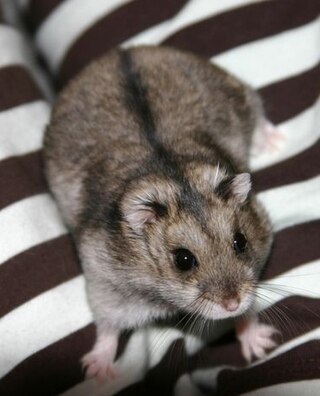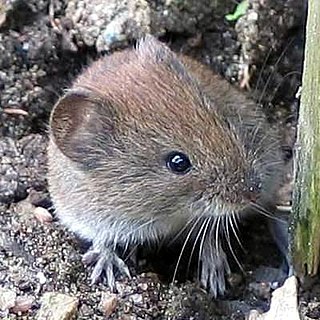Related Research Articles

Skunks are mammals in the family Mephitidae. They are known for their ability to spray a liquid with a strong, unpleasant scent from their anal glands. Different species of skunk vary in appearance from black-and-white to brown, cream or ginger colored, but all have warning coloration.

Musk is a class of aromatic substances commonly used as base notes in perfumery. They include glandular secretions from animals such as the musk deer, numerous plants emitting similar fragrances, and artificial substances with similar odors. Musk was a name originally given to a substance with a strong odor obtained from a gland of the musk deer. The substance has been used as a popular perfume fixative since ancient times and is one of the most expensive animal products in the world. The name originates from the Late Greek μόσχος 'moskhos', from Persian mushk and Sanskrit मुष्क muṣka derived from Proto-Indo-European noun múh₂s meaning "mouse". The deer gland was thought to resemble a scrotum. It is applied to various plants and animals of similar smell and has come to encompass a wide variety of aromatic substances with similar odors, despite their often differing chemical structures and molecular shapes.

The Asian palm civet, also called common palm civet, toddy cat and musang, is a viverrid native to South and Southeast Asia. Since 2008, it is IUCN Red Listed as Least Concern as it accommodates to a broad range of habitats. It is widely distributed with large populations that in 2008 were thought unlikely to be declining. It is threatened by poaching for the illegal wildlife trade.
Body odor or body odour (BO) is present in all animals and its intensity can be influenced by many factors. Body odor has a strong genetic basis, but can also be strongly influenced by various factors, such as sex, diet, health, and medication. The body odor of human males plays an important role in human sexual attraction, as a powerful indicator of MHC/HLA heterozygosity. Significant evidence suggests that women are attracted to men whose body odor is different from theirs, indicating that they have immune genes that are different from their own, which may produce healthier offspring.

The genus Spilogale includes all skunks commonly known as spotted skunks. Currently, there are four accepted extant species: S. gracilis, S. putorius, S. pygmaea, and S. angustifrons. New research, however, proposes that there may be up to seven.

The North American water vole or just water vole is the largest North American vole. It is found in the northwestern United States and southern parts of western Canada. This animal has been historically considered a member of genus Arvicola, but molecular evidence demonstrates that it is more closely related to North American Microtus species. Water voles are on the USDA Forest Service Region 2 sensitive species list because they maintain very small populations and there is high concern that their required habitat may be declining.

The eastern heather vole,, is a small North American vole. Until recently, this species was considered to belong to the same species as the western heather vole, Phenacomys intermedius. It is also called the Ungava vole.

Campbell's dwarf hamster is a species of hamster in the genus Phodopus. It was given its common name by Oldfield Thomas in honor of Charles William Campbell, who collected the first specimen in Mongolia on July 1, 1902. It is distinguished from the closely related Djungarian hamster as it has smaller ears and no dark fur on its crown. Campbell's dwarf hamster typically has a narrow dorsal stripe compared to the Djungarian hamster and brown or gray fur on the stomach. This hamster may be raised in captivity and kept as a small pet.
The anal glands or anal sacs are small glands near the anus in many mammals. They are situated in between the external anal sphincter muscle and internal anal sphincter muscle. In non-human mammals, the secretions of the anal glands contain mostly volatile organic compounds with a strong odor, and they are thus functionally involved in communication. Depending upon the species, they may be involved in territory marking, individual identification, and sexual signalling, as well as defense. Their function in humans is unclear.

Scent gland are exocrine glands found in most mammals. They produce semi-viscous secretions which contain pheromones and other semiochemical compounds. These odor-messengers indicate information such as status, territorial marking, mood, and sexual behaviour. The odor may be subliminal—not consciously detectable. Though it is not their primary function, the salivary glands may also function as scent glands in some animals.

The bank vole is a small vole with red-brown fur and some grey patches, with a tail about half as long as its body. A rodent, it lives in woodland areas and is around 100 millimetres (3.9 in) in length. The bank vole is found in much of Europe and in northwestern Asia. It is native to Great Britain but not to Ireland, where it has been accidentally introduced, and has now colonised much of the south and southwest.

The violet gland or supracaudal gland is a gland located on the upper surface of the tail of certain mammals, including European badgers and canids such as foxes, wolves, and the domestic dog, as well as the domestic cat. Like many other mammalian secretion glands, the violet gland consists of modified sweat glands and sebaceous glands.
Dogs, as with all mammals, have natural odors. Natural dog odor can be unpleasant to dog owners, especially when dogs are kept inside the home, as some people are not used to being exposed to the natural odor of a non-human species living in proximity to them. Dogs may also develop unnatural odors as a result of skin disease or other disorders or may become contaminated with odors from other sources in their environment.

The montane vole is a species of vole native to the western United States and Canada.

Alston's brown mouse, also called Alston's singing mouse, short-tailed singing mouse, or singing mouse, is a species of rodent in the family Cricetidae. It is found in Central America, from Chiapas, Mexico, to western Panama.

Rodents are mammals of the order Rodentia, which are characterized by a single pair of continuously growing incisors in each of the upper and lower jaws. About 40% of all mammal species are rodents. They are native to all major land masses except for Antarctica, and several oceanic islands, though they have subsequently been introduced to most of these land masses by human activity.
The Bruce effect, or pregnancy block, is the tendency for female rodents to terminate their pregnancies following exposure to the scent of an unfamiliar male. The effect was first noted in 1959 by Hilda M. Bruce, and has primarily been studied in laboratory mice. In mice, pregnancy can only be terminated prior to embryo implantation, but other species will interrupt even a late-term pregnancy.

The preorbital gland is a paired exocrine gland found in many species of artiodactyls, which is homologous to the lacrimal gland found in humans. These glands are trenchlike slits of dark blue to black, nearly bare skin extending from the medial canthus of each eye. They are lined by a combination of sebaceous and sudoriferous glands, and they produce secretions which contain pheromones and other semiochemical compounds. Ungulates frequently deposit these secretions on twigs and grass as a means of communication with other animals.

Scent rubbing is a behavior where a mammal rubs its body against an object in their environment, sometimes in ones covered with strongly odored substances. It is typically shown in carnivores, although many mammals exhibit this behavior. Lowering shoulders, collapsing the forelegs, pushing forward and rubbing the chin, temples, neck, or back is how this act is performed. A variety of different odors can elicit this behavior including feces, vomit, fresh or decaying meat, insecticide, urine, repellent, ashes, human food and so on. Scent rubbing can be produced by an animal smelling novel odors, which include manufactured smells such as perfume or motor oil and carnivore smells including feces and food smells.

Wolves communicate using vocalizations, body postures, scent, touch, and taste. The lunar phases have no effect on wolf vocalisation. Despite popular belief, wolves do not howl at the Moon. Gray wolves howl to assemble the pack, usually before and after hunts, to pass on an alarm particularly at a den site, to locate each other during a storm or while crossing unfamiliar territory, and to communicate across great distances. Other vocalisations include growls, barks and whines. Wolves do not bark as loudly or continuously as dogs do but they bark a few times and then retreat from a perceived danger. Aggressive or self-assertive wolves are characterized by their slow and deliberate movements, high body posture and raised hackles, while submissive ones carry their bodies low, sleeken their fur, and lower their ears and tail. Raised leg urination is considered to be one of the most important forms of scent communication in the wolf, making up 60–80% of all scent marks observed.
References
- 1 2 W. B. Quay, "The Specialized Posterolateral Sebaceous Glandular Regions in Microtine Rodents", Journal of Mammalogy, Vol. 49, No. 3 (Aug., 1968), pp. 427-445, accessed 29 October 2012
- 1 2 3 Jerry O. Wolff and Martha F. Johnson, "Scent Marking in Taiga Voles, Microtus xanthognathus" Journal of Mammalogy, Vol. 60, No. 2 (May, 1979), pp. 400-404, accessed 29 October 2012
- ↑ Cantoni et al., "Intra- and Interindividual Variation in Flank Gland Secretions of Free-ranging Shrews (Crocidura russula)". Journal of Chemical Ecology (1996) Vol. 22, No. 9, pp. 1669–88, accessed 29 October 2012
- ↑ A. S. Parkes and H. M. Bruce, "Olfactory Stimuli in Mammalian Reproduction" Science, New Series, Vol. 134, No. 3485 (Oct. 13, 1961), pp. 1049-1054, accessed 29 October 2012
- ↑ Frederick J. Jannett, Jr., "Drum-marking by Arvicola richardsoni and Its Taxonomic Significance", American Midland Naturalist, Vol. 92, No. 1 (Jul., 1974), pp. 230-234, accessed 29 October 2012
- ↑ Katherine Ralls, "Mammalian Scent Marking", Science, New Series, Vol. 171, No. 3970 (Feb. 5, 1971), pp. 443-449, accessed 29 October 2012
- ↑ Michael N. Lehman and David B. Adams, "A Statistical and Motivational Analysis of the Social Behaviors of the Male Laboratory Rat", Behaviour, Vol. 61, No. 3/4 (1977), pp. 238-275, accessed 29 October 2012
- ↑ Giora Heth, Josephine Todrank and Hynek Burda, "Individual Odor Similarities within Colonies and across Species of Cryptomys Mole Rats", Journal of Mammalogy, Vol. 83, No. 2 (May, 2002), pp. 569-575, accessed 29 October 2012
- ↑ Robert E. Johnston, "Chemical Communication in Rodents: From Pheromones to Individual Recognition", Journal of Mammalogy, Vol. 84, No. 4 (Nov., 2003), pp. 1141-1162, accessed 29 October 2012
- ↑ Jill M. Mateo and Robert E. Johnston, "Kin Recognition and the 'Armpit Effect': Evidence of Self-Referent Phenotype Matching", Proceedings: Biological Sciences, Vol. 267, No. 1444 (Apr. 7, 2000), pp. 695-700, accessed 29 October 2012
- ↑ Masakado Kawata, "Mating System and Reproductive Success in a Spring Population of the Red-Backed Vole, Clethrionomys Rufocanus Bedfordiae", Oikos, Vol. 45, No. 2 (Oct., 1985), pp. 181-190, accessed 29 October 2012
- ↑ Masakado Kawata, "Mating Success, Spatial Organization, and Male Characteristics in Experimental Field Populations of the Red-Backed Vole Clethrionomys rufocanus bedfordiae", Journal of Animal Ecology, Vol. 57, No. 1 (Feb., 1988), pp. 217-235, accessed 29 October 2012